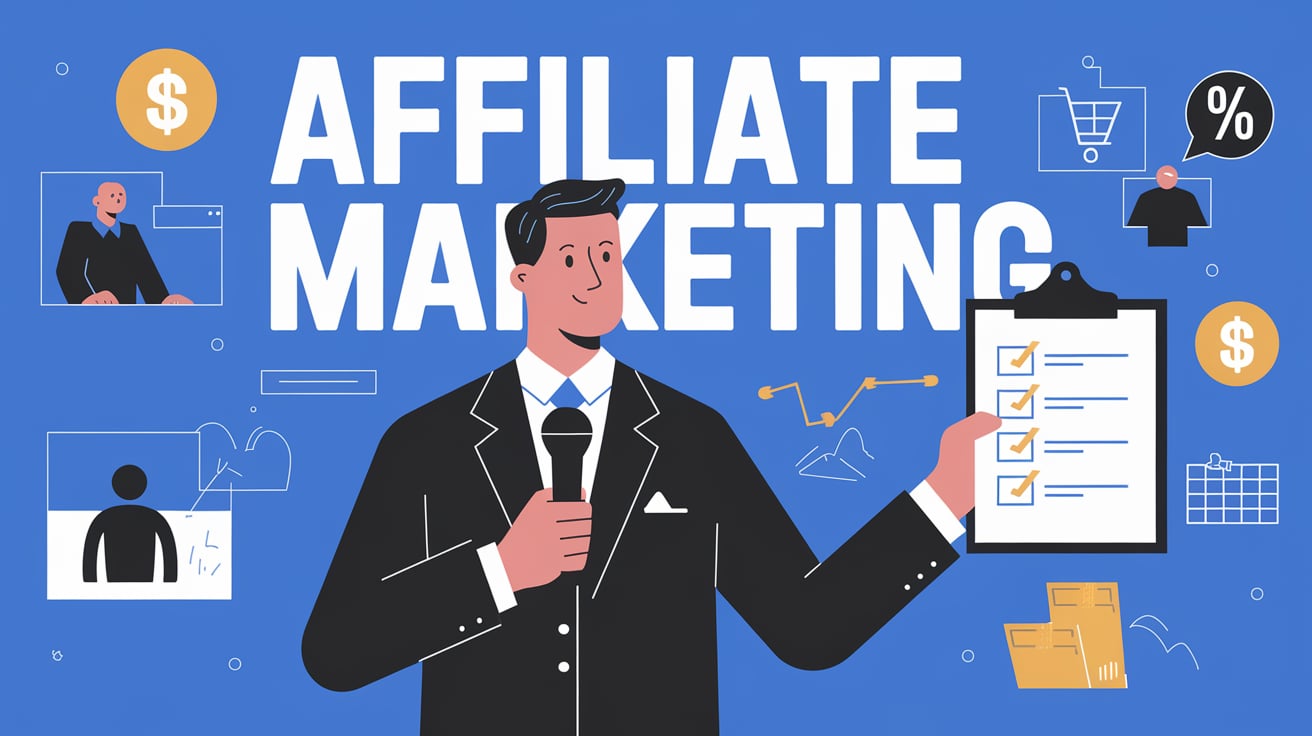Affiliate marketing has been a popular way to earn passive income for over two decades, and in 2025, it continues to be one of the most accessible and lucrative online business models. Whether you’re a complete beginner or someone looking to refine your skills, affiliate marketing offers endless opportunities to monetize your online presence. The best part? You don’t need a huge budget, a technical background, or even your own product to get started.
In this guide, we’ll walk you through everything you need to know to start affiliate marketing in 2025, from understanding the basics to building a sustainable income stream. Let’s dive in!
What is Affiliate Marketing?
Affiliate marketing is a performance-based marketing model where you promote other people’s products or services and earn a commission for every sale, lead, or action generated through your referral link. As an affiliate marketer, your role is to drive traffic to the merchant’s offer and convince your audience to take action.
Here’s a simple breakdown of how it works:
- You (the affiliate): Join an affiliate program and get a unique referral link.
- Your audience: Clicks on your link and makes a purchase or completes an action.
- The merchant: Tracks the sale or action and pays you a commission.
In 2025, affiliate marketing has evolved with advancements in technology, making it easier than ever to track performance, optimize campaigns, and scale your efforts.

Why Start Affiliate Marketing in 2025?
- Low Startup Costs: You don’t need to create your own product or invest heavily in inventory. All you need is a platform to promote affiliate offers.
- Passive Income Potential: Once you set up your campaigns, they can generate income even while you sleep.
- Flexibility: You can work from anywhere, promote products in any niche, and scale at your own pace.
- Growing E-commerce Industry: With the continued rise of online shopping, affiliate marketing is more relevant than ever.
- Advanced Tools and Platforms: In 2025, AI-powered tools, analytics, and automation make it easier for beginners to succeed.
Step 1: Choose Your Niche
Your niche is the specific area or topic you’ll focus on. Choosing the right niche is crucial because it determines your target audience, the products you promote, and your overall success.
Tips for Choosing a Niche:
- Passion and Knowledge: Pick a niche you’re passionate about or have some expertise in. This will make it easier to create content and connect with your audience.
- Market Demand: Ensure there’s a demand for products or services in your niche. Use tools like Google Trends, Amazon Best Sellers, or social media to research popular topics.
- Profitability: Look for niches with high-ticket products or recurring commissions. Examples include health and wellness, technology, finance, and online education.
- Competition: Avoid oversaturated niches unless you have a unique angle or strategy.
Step 2: Find Affiliate Programs
Once you’ve chosen your niche, the next step is to find affiliate programs that align with your audience’s interests. In 2025, there are countless affiliate networks and programs to choose from.

Popular Affiliate Networks:
- Amazon Associates: Great for beginners, as it offers a wide range of products.
- ShareASale: Features thousands of merchants across various niches.
- CJ Affiliate (Commission Junction): One of the largest and most reputable networks.
- Rakuten Advertising: Known for high-quality brands and offers.
- ClickBank: Ideal for digital products like eBooks, courses, and software.
Tips for Choosing Affiliate Programs:
- Look for programs with competitive commission rates.
- Check the cookie duration (the time frame in which you can earn a commission after a click).
- Read reviews and ensure the program is reputable.
- Consider recurring commissions for subscription-based products.
Step 3: Build Your Platform
Your platform is where you’ll promote affiliate offers and engage with your audience. In 2025, there are multiple platforms to choose from, depending on your skills and preferences.
ALSO READ: Top 10 Biggest Hospitals in the World
Popular Platforms for Affiliate Marketing:
- Blog/Website: A blog allows you to create in-depth content, optimize for SEO, and build a long-term asset. Use platforms like WordPress to get started.
- YouTube: Video content is highly engaging and can help you reach a broader audience.
- Social Media: Platforms like Instagram, TikTok, and Pinterest are great for visual niches.
- Email Marketing: Build an email list to nurture relationships with your audience and promote offers directly.
Tips for Building Your Platform:
- Focus on creating high-quality, valuable content that solves your audience’s problems.
- Optimize for SEO to drive organic traffic.
- Be consistent with your posting schedule.
- Engage with your audience through comments, messages, and emails.
Step 4: Create Content That Converts
Content is the backbone of affiliate marketing. Your goal is to create content that educates, entertains, and persuades your audience to take action.

Types of Content to Create:
- Product Reviews: Share honest reviews of products you’ve used or researched.
- How-To Guides: Teach your audience how to solve a problem using the product.
- Comparison Posts: Compare different products to help your audience make informed decisions.
- Listicles: Create lists like “Top 10 Tools for [Niche].”
- Video Tutorials: Demonstrate how to use a product or achieve a specific result.
Tips for Creating High-Converting Content:
- Use storytelling to connect with your audience emotionally.
- Include clear calls-to-action (CTAs) that encourage clicks on your affiliate links.
- Disclose your affiliate relationships to build trust with your audience.
- Use visuals like images, infographics, and videos to enhance your content.
Step 5: Drive Traffic to Your Content
In 2025, driving traffic to your content is easier than ever, thanks to the variety of tools and platforms available. Here are some effective strategies:
- Search Engine Optimization (SEO): Optimize your content for search engines to rank higher in search results.
- Social Media Marketing: Share your content on platforms like Instagram, TikTok, and LinkedIn.
- Paid Advertising: Use platforms like Google Ads or Facebook Ads to target specific audiences.
- Email Marketing: Send regular newsletters to your subscribers with valuable content and affiliate offers.
- Collaborations: Partner with other creators or influencers in your niche to reach a wider audience.
Step 6: Track and Optimize Your Performance
Tracking your performance is essential to understand what’s working and what’s not. In 2025, there are advanced tools and analytics platforms to help you monitor your campaigns.
Key Metrics to Track:
- Click-through rate (CTR)
- Conversion rate
- Earnings per click (EPC)
- Return on investment (ROI)
Tools to Use:
- Google Analytics: Track website traffic and user behavior.
- Affiliate Dashboards: Monitor clicks, sales, and commissions.
- Heatmap Tools: Analyze how users interact with your content.
Tips for Optimization:
- Test different types of content, CTAs, and promotional strategies.
- Focus on high-performing offers and double down on them.
- Continuously learn and adapt to changes in your niche and the industry.
Step 7: Scale Your Affiliate Marketing Business
Once you’ve mastered the basics and started earning consistent income, it’s time to scale your efforts. Here are some ways to grow your affiliate marketing business in 2025:

- Diversify Your Income Streams: Promote products from multiple affiliate programs or explore other monetization methods like sponsored content.
- Automate Repetitive Tasks: Use tools like email autoresponders and social media schedulers to save time.
- Outsource: Hire freelancers to handle tasks like content creation, graphic design, or SEO.
- Expand Your Reach: Explore new platforms, niches, or markets to grow your audience.
NOTE
Affiliate marketing in 2025 is an exciting and rewarding opportunity for beginners. With the right mindset, strategies, and tools, you can build a sustainable online business that generates passive income for years to come. Remember, success in affiliate marketing doesn’t happen overnight. It requires patience, consistency, and a willingness to learn and adapt.
Start small, focus on providing value to your audience, and gradually scale your efforts. By following the steps outlined in this guide, you’ll be well on your way to becoming a successful affiliate marketer in 2025. Happy promoting!
Call to Action: Ready to start your affiliate marketing journey? Share your thoughts or questions in the comments below, and don’t forget to subscribe for more tips and strategies!


1 thought on “How to Start Affiliate Marketing for Beginners in 2025: A Step-by-Step Guide”